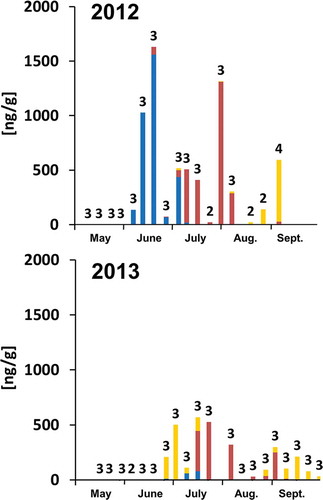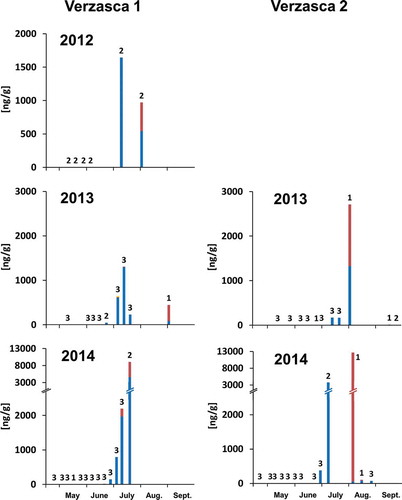Figures & data
Table 1. PA concentrations in Swiss pollen on the retail market.
Table 2. Pollen for the retail market produced at our observation site in Basel.
Figure 1. Appearance of PAs in daily collected pollen samples from Basel. In total, 49 pollen samples were collected in 2012 and 59 samples in 2013. Numbers express the number of pollen samples collected from different hives at a specific day from which the average PA concentration is calculated. Blue: Echium-type PAs; dark red: Eupatorium-type PAs; yellow: Senecio-type PAs.

Figure 2. Appearance of PAs in daily collected pollen samples from Verzasca. In total, 12 pollen samples were collected in 2012, 24 samples in 2013 and 36 samples in 2014 in Verzasca 1. Twenty-six samples were collected in 2013 and 34 samples in 2014 in Verzasca 2. Numbers express the number of pollen samples collected from different hives at a specific day from which the average PA concentrations were calculated. Blue: Echium-type PAs; dark red: Eupatorium-type PAs; yellow: Senecio-type PAs.

Table 3. PA pattern in daily collected pollen samples compared to the PA pattern in flower heads of E. vulgare, E. cannabinum and Senecio spp. Daily collected pollen samples were from Basel (sample 2: June 2012; samples 1 and 3: July 2013), from Verzasca 1 (samples 4 and 5: July 2013; sample 6: September 2013) and from Verzasca 2 (sample 7: August 2013). Median and concentration range are listed for flower heads of Echium vulgare L. (n = 16), Eupatorium cannabinum L. (n = 6) and Senecio species (n = 15; comprising S. alpinus (L.) Scop., S. doronicum (L.) L., S. erucifolius L., S. jacobaea L., S. ovatus (P. Gaertn. et al.) Willd., S. viscosus L. and S. vulgaris L.). blue: Echium-type PAs; dark red: Eupatorium-type PAs; yellow: Senecio-type PAs. (1) putative identification; (2) PAs present in E. vulgare and E. cannabinum; nd: not detected (< LOD); Ac, acetylated; O, N-oxide.
